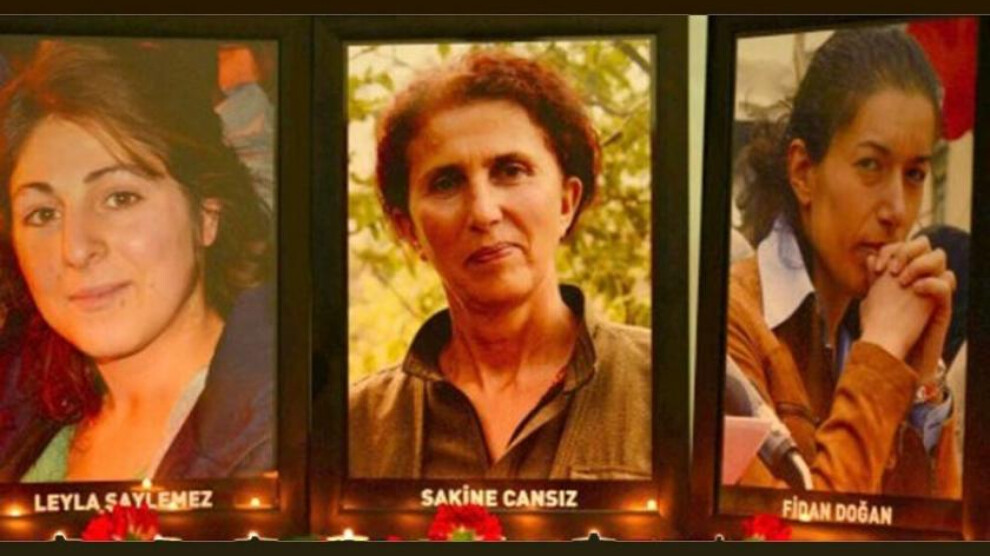Women using their lives as shields for peace…
Women keep struggling for S akine Cansız, Fidan Doğan and Leyla Şaylemez and chant once more: Jin, Jiyan, Azadi.

Sarya Deniz
News Center- Sakine Cansız, one of the founders of the PKK, showed in every sphere of her life that living is a form of resistance. Many times, she had a close brush with death when she served in the Diyarbakır Prison, where torture was experienced at its darkest and most brutal, for 10 years. But she was never afraid and gave up struggling. Sakine Cansız, Fidan Doğan, Paris Representative of the Kurdistan National Congress (KNK) and Leyla Şaylemez, member of the Kurdish youth movement, were murdered on January 9, 2013, one of the coldest days of 2013.
The massacre and lawsuit process
Sakine Cansız, Fidan Doğan and Leyla Şaylemez were murdered on January 9, 2013 at the Kurdistan Information Center in Paris. Just after the massacre, the murderer Ömer Güney was arrested. In 2013, an investigation was launched against him for murdering the three women. The investigation was completed in May 2015. The first hearing of the murder trial was expected to be held on January 23, 2017; however, Ömer Güney died in prison on December 17, 2016 under suspicious circumstances. France did not carry out an effective investigation into the massacre and considered the murder case as a normal murder case although there was some evidence that showed that the Turkish Intelligence Organization (MİT) had a role in the massacre.
The aim was to show the massacre as a massacre that was planed and committed by a person
When Ömer Güney was in prison, his relationship with the agents of MIT in Germany and Belgium was revealed. House raids conducted by the German police prevented the escape plan of Ömer Güney from Salpêtrière Hospital in Paris with the logistic support of the MIT. Despite the evidence revealed in Germany and Belgium, no step was taken to reveal the dark forces behind the massacre. The aim was to show the massacre as a massacre that was planned and committed by a person, who was ‘mentally ill’.
In which process the massacre took place?
Surely, this massacre was not an ordinary murder case. There was professional power behind it. Before the massacre, Kurdish leader Abdullah Öcalan was not allowed to meet with her family and lawyers from 27 July 2011 and 3 January 2013. On September 12, 2012, Kurdistan Workers Party (PKK) and Kurdistan Women’s Liberation Party (PAJK) prisoners in all Turkish prisons started a hunger strike. The hunger strike ended on its 68th day after Abdullah Öcalan’s brother Mehmet Öcalan met him in Imrali prison. On January 3, 2013, Democratic Society Congress (DTK) former Co-chair Ahmet Türk, Peace and Democracy Party (BDP) Batman MP Ayla Akat Ata met Abdullah Öcalan, the first meeting of the peace process, which ended on January 3, 2015. The massacre in Paris came just a few days after an initiative to launch a new process of peace between the Turkish government and the PKK. The aim of the massacre was to end the peace process.
Women promised to maintain their struggle
Three women, who are symbols of peace for the Kurdish people, were laid to rest by thousands of women in France and Turkey. Sakine Cansız was buried in Dersim. At the funeral ceremony, women promised to maintain the struggle of Sakine Cansız by chanting the slogan, “Jin, Jiyan, Azadi (English: Women, Life, Freedom)”. Fidan Doğan was laid to rest in the Nuhak district of Maraş province. Leyla Şaylemez was buried in Mersin. Thousands of women attended their funerals. Today, women follow in the footsteps of Sakine Cansız and her comrades by saying, “Berwwedan jiyane/ To live is to resist”.
Ban from the Dersim Governorate
The Dersim Governor's Office announced that entrances and exits to the Korkes (Türkish: Sütlüce) village have been restricted until January 9, 2023 on the grounds that a commemoration would be held for Sakine Cansız.
There is a three-meter-high memorial wall of Sakine Cansız in Dersim Asri Cemetery, 2 kilometers from the city center. There is a photograph of Sakine Cansız and stars and pigeon wings on the wall.
